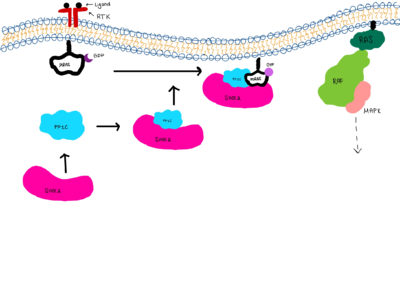Enolase
From Proteopedia
(Difference between revisions)
| Line 1: | Line 1: | ||
<StructureSection load='1one' size='450' side='right' caption='Yeast enolase dimer complex with phosphoenolpyruvate and phosphoglycerate, [[1one]]' scene='Enolase/Enolase/1'><scene name='Cory_Tiedeman_Sandbox_1/Enolase/1'>Enolase</scene> is an enzyme that catalyzes a reaction of glycolysis. [[Glycolysis]] converts glucose into two 3-carbon molecules called pyruvate. The energy released during glycolysis is used to make ATP.<ref>{{textbook |author=Voet, Donald; Voet, Judith C.; Pratt, Charlotte W.|title=Fundamentals of Biochemistry: Life at the Molecular Level|edition= 3|pages=487|}}</ref> Enolase is used to convert 2-phosphoglycerate (2PG) to phosphoenolpyruvate (PEP) in the 9th reaction of glycolysis: it is a reversible dehydration reaction.<ref>{{textbook |author=Voet, Donald; Voet, Judith C.; Pratt, Charlotte W.|title=Fundamentals of Biochemistry: Life at the Molecular Level|edition= 3|pages=500|}}</ref>. Enolase is expressed abundantly in most cells and has been proven useful as a model to study mechanisms of enzyme action and structural analysis <ref>{{journal}}</ref>. As with the reaction below, Enolase must have a divalent metal cation present to activate or deactivate the enzyme. The best cofactor would be Mg2+, but many, including Zn2+, Mn2+ and Co2+ can be used. The metal ion works by binding to the enzyme at the active site and producing a conformational change. This makes it possible for the substrate (2-PGA) to bind at the Enolase active site. Once this happens, a second metal ion comes in and binds to the enzyme to activate the Enolase catalytic ability. For sequence alignment see [[Enolase multiple sequence alignment]]. | <StructureSection load='1one' size='450' side='right' caption='Yeast enolase dimer complex with phosphoenolpyruvate and phosphoglycerate, [[1one]]' scene='Enolase/Enolase/1'><scene name='Cory_Tiedeman_Sandbox_1/Enolase/1'>Enolase</scene> is an enzyme that catalyzes a reaction of glycolysis. [[Glycolysis]] converts glucose into two 3-carbon molecules called pyruvate. The energy released during glycolysis is used to make ATP.<ref>{{textbook |author=Voet, Donald; Voet, Judith C.; Pratt, Charlotte W.|title=Fundamentals of Biochemistry: Life at the Molecular Level|edition= 3|pages=487|}}</ref> Enolase is used to convert 2-phosphoglycerate (2PG) to phosphoenolpyruvate (PEP) in the 9th reaction of glycolysis: it is a reversible dehydration reaction.<ref>{{textbook |author=Voet, Donald; Voet, Judith C.; Pratt, Charlotte W.|title=Fundamentals of Biochemistry: Life at the Molecular Level|edition= 3|pages=500|}}</ref>. Enolase is expressed abundantly in most cells and has been proven useful as a model to study mechanisms of enzyme action and structural analysis <ref>{{journal}}</ref>. As with the reaction below, Enolase must have a divalent metal cation present to activate or deactivate the enzyme. The best cofactor would be Mg2+, but many, including Zn2+, Mn2+ and Co2+ can be used. The metal ion works by binding to the enzyme at the active site and producing a conformational change. This makes it possible for the substrate (2-PGA) to bind at the Enolase active site. Once this happens, a second metal ion comes in and binds to the enzyme to activate the Enolase catalytic ability. For sequence alignment see [[Enolase multiple sequence alignment]]. | ||
| - | {{TOC limit|2}} | ||
==Structure== | ==Structure== | ||
The <scene name='Cory_Tiedeman_Sandbox_1/Secondary_structure/1'>secondary structure</scene> of enolase contains both alpha helices and beta sheets. The beta sheets are mainly parallel<ref>{{web site| title=SCOP: Protein: Enolase from Baker's yeast (Saccharomyces cerevisiae)|url=http://scop.mrc-lmb.cam.ac.uk/scop/data/scop.b.d.b.bc.b.b.html|}}</ref>. As shown in the figure, enolase has about 36 alpha helices and 22 beta sheets (18 alpha helices and 11 beta sheets per domain). Enolase consists of two domains. | The <scene name='Cory_Tiedeman_Sandbox_1/Secondary_structure/1'>secondary structure</scene> of enolase contains both alpha helices and beta sheets. The beta sheets are mainly parallel<ref>{{web site| title=SCOP: Protein: Enolase from Baker's yeast (Saccharomyces cerevisiae)|url=http://scop.mrc-lmb.cam.ac.uk/scop/data/scop.b.d.b.bc.b.b.html|}}</ref>. As shown in the figure, enolase has about 36 alpha helices and 22 beta sheets (18 alpha helices and 11 beta sheets per domain). Enolase consists of two domains. | ||
Revision as of 11:00, 17 August 2014
| |||||||||||
References
- ↑ Voet, Donald, Judith G. Voet, and Charlotte W. Pratt. Fundamentals of Biochemistry: Life at the Molecular Level. 3rd ed. Hoboken, NJ: John Wiley & Sons, Inc., 2008.
- ↑ Voet, Donald, Judith G. Voet, and Charlotte W. Pratt. Fundamentals of Biochemistry: Life at the Molecular Level. 3rd ed. Hoboken, NJ: John Wiley & Sons, Inc., 2008.
- ↑ Pancholi, V. "Multifunctional a-Enolase: Its Role in Diseases." CMLS, Cellular and Molecular Life Sciences 58 (2001): 902-20.
- ↑ The scop authors. Structural Classification of Proteins. “Protein: Enolase from Baker's yeast (Saccharomyces cerevisiae). 2009. 2/26 2010. [<http://scop.mrc-lmb.cam.ac.uk/scop/data/scop.b.d.b.bc.b.b.html>.]
- ↑ The scop authors. Structural Classification of Proteins. “Protein: Enolase from Baker's yeast (Saccharomyces cerevisiae). 2009. 2/26 2010. [<http://scop.mrc-lmb.cam.ac.uk/scop/data/scop.b.d.b.bc.b.b.html>.]
- ↑ Nguyen, Tram, and Katelyn Thompson. "Mechanism of Enolase Converting 2-Phosphoglycerate to Phosphoenolpyruvate." ChemDraw 10.0: Public Domain, 2008. [1].
- ↑ Voet, Donald, Judith G. Voet, and Charlotte W. Pratt. Fundamentals of Biochemistry: Life at the Molecular Level. 3rd ed. Hoboken, NJ: John Wiley & Sons, Inc., 2008.
- ↑ Westhead, E. W., and BO G. Malmstrom. "The Chemical Kinetics of the Enolase Reaction with Special References to the Use of Mixed Solvents." The Journal of Biological Chemistry 228 (1957): 655-71.
- ↑ Westhead, E. W., and BO G. Malmstrom. "The Chemical Kinetics of the Enolase Reaction with Special References to the Use of Mixed Solvents." The Journal of Biological Chemistry 228 (1957): 655-71.
- ↑ Pancholi, V. "Multifunctional a-Enolase: Its Role in Diseases." CMLS, Cellular and Molecular Life Sciences 58 (2001): 902-20.
Proteopedia Page Contributors and Editors (what is this?)
Michal Harel, David Canner, Alexander Berchansky, Jaime Prilusky, Cory Tiedeman, Joel L. Sussman

![V vs. [PGA]; PGA is 2PG, the top curve has [Mg2+] of 10^-3 M and the bottom curve has [Mg2+] of 106-2 M](/wiki/images/thumb/1/10/Enolase_kinetics.jpeg/200px-Enolase_kinetics.jpeg)
